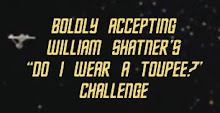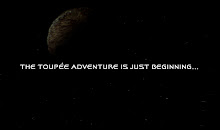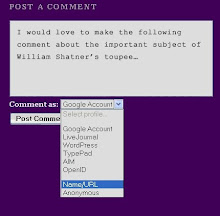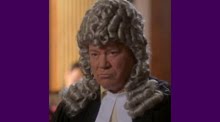And so there was a sequel: Khan. Genesis. Kirk's son. Spock dies...
1982's Star Trek II: The Wrath of Khan is widely considered as either one of the best, or indeed the best of the original series big screen outings.
Firstly, why was this film ever made? For all its creative failings and production turmoil 1979's Star Trek: The Motion Picture managed to rake-in a respectable $139 million worldwide against what was then an astronomical budget of $46 million (a barley acceptable 302 percent return; incidentally 1977's Star Wars cost only $11 million and ended up making $775.4 million - a 7,049 percent return!).
Asides from satiating a hungry army of Star Trek fans, we suspect that a considerable part of ST:TMP's box office success was a direct result of the Star Wars boom - for many non-Trekkers, the Enterprise crew's premiere big screen outing served as a sufficient sci-fi fix in the run up to the mid-1980 release of The Empire Strikes Back.
In many ways, Star Wars (1977) was more like the Star Trek TV series than ST:TMP
And so Star Wars saved Star Trek not once, but twice. Fox had a franchise in Star Wars. Did Paramount have one in Star Trek?
"The Creator" Gene Roddenberry was out. Kicked upstairs to the ceremonial role of Executive Consultant. TV producer Harve Bennett instead assumed the reigns. "Could you make [a better picture] for less than forty-five f*@#ing million dollars?" Bennett recalled a studio exec asking him.
"Oh boy, where I come from, I could make five movies for that."
Harve Bennet and Gene Roddenberry.
After a few months, however, Bennett and writer Jack Sowards were stuck in rewrite hell. Lots of ideas, but no workable script. Enter the famously neurotic writer-director Nicholas Meyer. He described a meeting with Bennett and fellow producer Robert Sallin:
"Why don’t we make a list of everything we like in these five drafts? Could be a plot, a subplot, a sequence, a scene, a character, a line even . . .And then I will write a new script and cobble together all the things we choose."
A miraculously quick rewrite ensued, which led to a rather miraculous script.
Testing the waters? Bill Shatner performs a scalp meld on director Nicholas Meyer.
We should note that at this point in the history of Star Trek, the behind-the-scenes story and on-screen antics of the Starship Enterprise essentially fuse into one.
During the 1980s, it wasn't enough to merely go see Treks II, III, IV etc... Rather, in magazines such as Starlog and Cinefantastique, fans could learn about every aspect of how these films were made, from discarded story ideas to the effects magic of ILM. All part of the package...
Creating a nebula in a tank - source.
Another crucial factor in Star Trek II was Leonard Nimoy's initial reluctance to return for a "cash-in" adventure: "I really was adamant that I would not work on Star Trek II because I had been so frustrated with [The Motion Picture] and I was feeling very negative about the whole thing," the actor recalled.
But Harve Bennet had a potentially irresistible hook: "Leonard, how would you like to play your death scene?" the producer asked Nimoy over the phone. Spock was in.
So this sequel ended up defying logic - the fragmented nature of its construction actually helped rather than hindered the final product. Crucially, the audience watches a story unfold with no idea about what will happen next...
Star Trek II: The Wrath of Khan is responsible for creating something of a storytelling fallacy: discard the loftiness of the original and bring in a bad-ass "black hat" villain in the sequel. Wham! Bang! Boom! That's more like it!
As director Bryan Singer said of his never-realised plans for a sequel to (the yawn-fest that was) 2006's Superman Returns: "I plan to get all Wrath of Khan on it." Flash forward to 2013 and the literal sequel to the literal re-boot of the Star Trek franchise, which literally brings back Khan; and, in case that wasn't subtle enough, it was literally called Into Darkness. Get it? Dark. Villain. Is we becoming more dumber?
Khan - now blond and mulleted.
But the strengths of the 1982 sequel arguably have very little to do with Khan alone. Indeed, he is barely in the movie. Stuck on the bridge of the starship Reliant spouting histrionic tongue-twisters, one could even argue that the villain represents the weakest part of The Wrath of Khan, a mere shadow of the devious, ultra-manipulative tyrant of the original series episode "Space Seed".
A possible key reason for The Wrath of Khan's strong script is that it avoided the narrative traps, which to greater or lesser extent ensnared no less than four of the original Trek films:
ST: I - We'll get there and see something amazing!
ST: III - We'll get there and hopefully find something amazing (and then bring it back)!
ST: IV - We'll get there and hopefully find something amazing (and then bring it back)!
ST: V - We'll get there and see something amazing!
ST:TMP - staring and waiting to get there...
Only II and VI present story structures, which are more snake-like, meaning countless unexpected twists and turns. VI, we would argue, is less successful at this with its somewhat muddled murder-mystery plot. From a storytelling viewpoint Star Trek II is mature, literate and bursting with all kinds of well-woven themes and tensions. And that has very little to do with the cliché about "getting all Wrath of Khan on it". That is just far too simplistic.
Star Trek II isn't about explosions and villains - it is about life and death; old age and the creation of life; friendship and family; love and loss. It is Horatio Hornblower meets Charles Dickens. Back in 1958, Robert Wise, director of ST:TMP, directed a submarine movie called Run Silent, Run Deep - ironically, very similar to Meyer's deliberately more militaristic and claustrophobic Star Trek film...
The production also included contentious re-shoots, filmed without
Meyer's participation, in which Spock's death was made less final. As
the end of production neared, it became clear that this movie might
actually be good - so what the hell have we done by killing Spock? Backpedaling ensued, from "Remember..." to a coffin on Genesis. The groundwork had been laid for a Star Trek III.
"Remember..." (to leave room for a sequel)
For all the it's strengths, including a terrific score by James Horner, other movies in the series arguably do better in terms of cinematography (III and IV) and production design (again III and IV). Star Trek II never looked very good on home video with its very 1982-ish yellow-blood red color palette.
When the Enterprise bridge goes red for red alert, it goes almost totally red, which always looked pretty horrible on VHS and even DVD.
"Bleeding" reds on home video.
Speaking of Gayne Rescher's cinematography, why is Khan's Reliant bridge lit so cheerfully bright (with hints of minty green), while the Enterprise - along with the rest of the movie - is lit with far greater broodiness and contrast?
Odd mismatch - the "bright" villainous Khan and the very red Enterprise.
But there is something of a revelation to be had here, too: for anyone who hasn't seen this movie remastered on Blu-ray (hitherto the only one of the six properly restored for release on this format) we strongly recommend it. Though still unusual in terms of its aesthetic feel, the movie looks far better. The conscious effort to move away from the muted, under-lit look of ST:TMP and revive some of the colored gel techniques used in the Original Series leaps through the screen with a clarity not seen since Khan was released in cinemas.
In summary: certainly Khan suffers less from its low budget than TMP suffered from its excessive budget. But the lack of any location photography (until the tacked-on ending) is somewhat stifling, and the interior Genesis Cave (pictured above) set is rather odd and implausible. And, of course, Khan and Kirk never meet face to face. Lots of small gripes like that, but overall very successful.
Let's move swiftly to the hair...
Bill Shatner promotes Khan on the Merv Griffin Show. Note the easily identifiable demarcation line between toup and real hair.
The immovable "patty" of TMP is laid to rest in Star Trek II.
Rather, the hair returns to a slightly less perfect state, akin to the toup seen in newly-revealed (thanks to readers for tip) costume/makeup tests for Star Trek: The Motion Picture:
Bill Shatner in 1978, before he went on a crash diet. Note the less patty-like hair.
All part of a conscious effort by both Meyer and Bennet to have the characters look like they had aged since TOS. "I had to be dragged in kicking and screaming," Bill Shatner recalled of his reluctance with regards to spotlighting the middle-agedness of Captain Kirk.
While III has wind and IV has water, II sees very little physical action to challenge or disrupt the toupee. Perhaps this is why the movie represents the final Trek appearance of the "cap" version of the "T.J. Curly". For the next movies (no doubt caused by the demands of the very physical T.J. Hooker TV series in which the actor was starring) a sturdier, more resilient "T.J. Curly" would be affixed to the top and also the sides of the head.
An occasional flaw is visible (top left), but no real "toupological moments"
The closest we could find to a real "MTI" (Moment of Toupological Interest) was a shot from the end of the movie:
This, too, we believe, was part of the non-Meyer re-shoots. For some reason, there is an almost "Afro" look to Bill Shatner's hair in the wide shot. Why does the hair suddenly seem so curly? Is it to help visualize that Kirk is wound-up over the loss of Spock?
Finally, it is with great sadness that we publish this review at a time when three de facto "torch-holding producers" of the Star Trek franchise have passed away, all within the space of a little over a week - Maurice Hurley (a kind of Trotsky figure to Rick Berman's Stalin), Leonard Nimoy and Harve Bennett.
Bill Shatner made some eyebrow-raising headlines with regards to Leonard Nimoy's passing. Sometimes, the behind-the-scenes stories are far more complex, and the reactions of those who survive are not what we expect...
We note that Paul McCartney had not seen John Lennon for four years when his "brother" was tragically shot in December 1980. Never the most comfortable about expressing his feelings publicly, the devastated and deeply shocked former Beatle was unfairly berated for calling the news "a drag".
"We just don't have that kind of a relationship anymore - we used to..." Nimoy lamented of Shatner in a 2014 interview with Piers Morgan. The once brotherly pair seemed to have stopped their mutual Twitter banter some time ago, too. Were they really as close friends as Kirk and Spock? Did they have some kind of falling out? And do Kirk's rhetorical words in Star Trek II apply at all here?: "...how we deal with death is at least as important as how we deal with life, wouldn't you say?"
There are always possibilities...
Leonard Nimoy (1931-2015) and Harve Bennett (1930-2015)












































